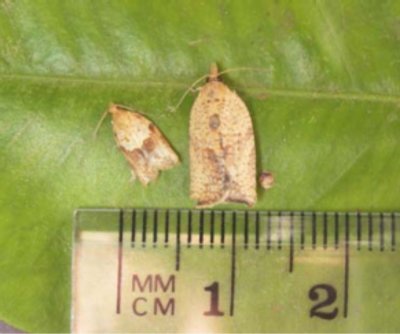
After weeks of trapping, state and federal officials say that an infestation of a foreign pest that could pose a significant threat to the state's agriculture – particularly crops which thrive in Lake County – still appears to be confined to two Bay Area counties.
The light brown apple moth was first detected in traps in Alameda and Contra Costa counties Feb. 27, California Department of Food and Agriculture (CDFA) spokesman Steve Lyle said.
CDFA reported that the light brown apple moth is native to Australia and is found in New Zealand, Ireland, the United Kingdom and Hawaii.
Since the pest's initial discovery, traps have been placed in several additional counties, said Lyle, including Marin, San Francisco, Santa Clara, San Mateo, Solano, Napa, Yolo, Sonoma, Los Angeles, Orange and San Diego.
Larry Hawkins, a spokesman for the U.S. Department of Agriculture's Animal and Plant Health Inspection Service, said that 2,648 traps from around the state have been inspected so far, with 31 light brown apple moths discovered in Alameda and Contra Costa counties only.
Because the moths are hard to identify, Hawkins said, a confirmation process has been put in place to make definitive identifications. Several more moths found in the traps are still to be identified, he added.
USDA has set up a technical working group which will help find solutions for dealing with the infestation, said Hawkins.
The group, which has met once so far, includes members from New Zealand – which has extensive experience with the moth, Hawkins said – and the U.S., including members specifically from Hawaii, where the moth has been present for some time.
The working group helps answer important questions for USDA's operational field staff, said Hawkins, by contacting researchers who have studied the moth in order to gather more data.
One of the big questions the group is still working to answer, he said, is just how many host plants the moth has. The numbers have ranged widely, with some estimates at 200 plants and others as large as 250, he said.
“We do not have a final, definitive host list that's been provided yet,” said Hawkins.
Some of the crops the moth is known to damage include pears and grapes, apples, citrus and stone fruit (peaches, plums, nectarines, cherries and apricots), CDFA reported. It also destroys, stunts or deforms young seedlings, spoils the appearance of ornamental plants and injures deciduous fruit-tree crops.
Lyle said the moths were found in traps placed in backyard trees in Bay Area neighborhoods. He added that invasive pests often “hitch rides” into new territories on landscaping and ornamental plants, with pest detections and eradications often happening in urban neighborhoods.
“The concern we have is it moves out of that area and into production agriculture,” said Lyle.
In an effort to control the pest spreading into other areas, this week CDFA established regulatory measures that require certifications and inspections of wholesale and retail nursery stock, and prevent removal of certain fruits and vegetables from community and school gardens.
Rachel Elkins, the University of California Cooperative Extension pomology farm advisor for Lake County, said the light brown apple moth is a “leafroller,” which feed on the surface of fruits, not necessarily boring into them.
CDFA apparently kept the discoveries of the bugs well under wraps. Bob Van Steenwyk, a UC Cooperative Extension entomologist who is a member of the UC Berkeley Entomology Department, said the state's insect experts have only begun hearing about the detections in the middle of the month.
Lake County Agricultural Commissioner Steve Hajik said he received his first notice about the pest's discovery around the third week of March.
Hajik said there are concerns about what the pest could do to Lake County's crops if it were to spread here. However, he cautioned, it's still too early in the detection and study process to know the moth's possible consequences.
He added that he hasn't yet received a game plan from CDFA about how the moth will be dealt with. Hajik said the moth is apparently attracted to pheromones, which make it easier to detect in crops.
Lyle said CDFA is still trying to figure out the size of the moth's infestation and isn't willing to say how it might treat for the pest. Quarantines of the affected areas may become necessary, he added.
CDFA has given the light brown apple moth an “A” rating, “the most serious rating we have,” said Lyle. “This is a serious pest, and we're very concerned.”
Van Steenwyk said he visited New Zealand several years ago, where he saw the moth firsthand.
He said there are many leafroller moths already in California, but the light brown apple moth will likely have a “different niche” than some of the others.
Van Steenwyk said he expected this moth would probably be more attracted to cooler weather. “This one could swing north to Lake County and Sacramento,” he said.
Only two of the leafrollers in the state get into grapes, said Van Steenwyk, and this would be one of them.
Van Steenwyk said the moth has been controlled successfully with organic sprays in New Zealand and Australia. The trick, he said, will be eradicating it in urban areas, where residents aren't likely to welcome spraying, even if it's organic.
“What will be the best material and how it all shakes out, it will take a little research but we'll have it figured out in not too much time,” he said.
Ultimately, Lyle said, the decision on eradication measures must be made by the USDA in conjunction with the agricultural commissioners of the counties where the pest is found.
E-mail Elizabeth Larson at
{mos_sb_discuss:2}

 How to resolve AdBlock issue?
How to resolve AdBlock issue? 



